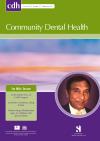Community Dental Health

- Cover Date:
- September 2011
- Print ISSN:
- 0265 539X
- Vol:
- 28
- Issue:
- 3
Dental self-care and visiting behaviour in relation to social inequality in caries experience
Objectives: To investigate associations of dental behaviour with social inequality in oral health. Methods: A random sample of 45-54 year-olds from Adelaide, South Australia was surveyed by self-complete questionnaire in 2004-05 (n=879, response rate 43.8%). Oral examinations were performed by calibrated dentists on 709 persons (80.7% of participants). Results: The mean (SE) number of decayed teeth (D) was 0.4 (0.04), with 5.3 (0.2) missing teeth (M), 11.0 (0.2) filled teeth (F) and 16.6 (0.2) DMFT. The majority brushed their teeth 8 or more times per week (78.8%) and had made a dental visit within the last 12 months (63.7%). Nearly a quarter had a household income of under $30,000 (24.0%). Multivariate analysis showed a three-way interaction (p<0.05, GLM) between income and brushing and visiting for decayed teeth, showing that the relationship between decayed teeth and dental behaviour varied across levels of income. Among those who had not made a dental visit in the last 12 months, those who brushed their teeth 8 or more times per week in the low income group had D=0.7 (0.2) while those who brushed less often had D=2.2 (0.5) compared to D=0.3 (0.08) and D=0.3 (0.2) respectively in the high income group. Conclusion: Dental behaviour in terms of brushing and visiting was associated with social gradients in oral health for decayed teeth across income groups, with less favourable dental behaviour having a stronger negative association with oral health among lower income groups.
Key words: caries experience, dental behaviour, SES
- Article Price
- £15.00
- Institution Article Price
- £
- Page Start
- 216
- Page End
- 221
- Authors
- D.S. Brennan, A.J. Spencer, K.F. Roberts-Thomson
Articles from this issue
- Title
- Pg. Start
- Pg. End
- Investing in professional advocacy: a case study of a successful fluoridation campaign in rural New South Wales, Australia
- 0
- 0
- Tooth wear and erosion: Methodological issues in epidemiological and public health research and the future research agenda
- 191
- 195
- The efficacy of dentifrices on extrinsic tooth stains among community dwelling adults in India – a randomised controlled trial
- 201
- 205
- Clinical and socio-demographic factors influencing the oral health-related quality of life of Chinese elders
- 206
- 210
- The effects of chronic pain on oral health related quality of life in patients with anterior disc displacement with reduction.
- 211
- 215
- Dental self-care and visiting behaviour in relation to social inequality in caries experience
- 216
- 221
- Clinical evaluation of chlorhexidine for the control of dental biofilm in children with special needs
- 222
- 226
- Psychometric properties of long and short forms of the Child Perceptions Questionnaire (CPQ11-14) in a Thai population
- 232
- 237
- Dental examiners consistency in applying the ICDAS criteria for a caries prevention community trial
- 238
- 242
